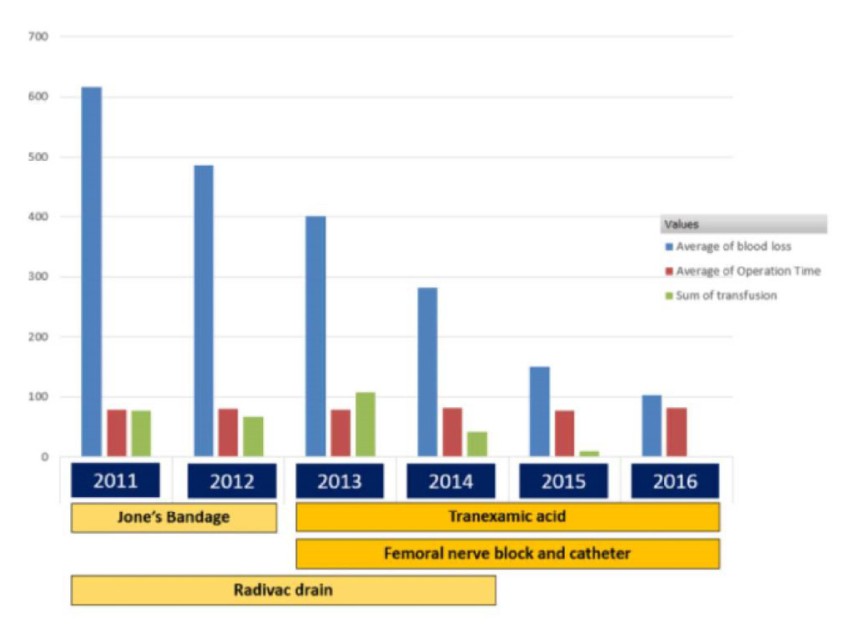FACTORS RELATED TO BLOOD LOSS IN TOTAL KNEE ARTHROPLASTY
DOI:
https://doi.org/10.55374/jseamed.v2i2.13Keywords:
Blood loss, TKA, Radivac drain, Transfusion, Traneamic acidAbstract
Introduction:Main population of total knee arthroplasty are elderly group which contained of risks from procedure and medical condition. The amount of blood loss in TKA vary in different studies. Blood loss from TKA may cause the change of hemodynamic status, risked to cardiovascular morbidity or mortality. Allogenic blood transfusion, associated with many immunological and transfusion complications, increased cost of surgery. Factors associated with blood loss should controlled to decreased blood loss and complications. Objectives:Determination of risk factors for blood loss is a significant step toward blood management. This study is also used calculated blood loss, which more accurate than visible blood loss. Methods:Medical records of 517 patients who underwent TKA from 2011 to 2016 were examined, blood loss was calculated by Gross' formula. Pearson 's correlation and multiple regression analyses were performed to identify factors associated to blood loss. Results:The mean calculated blood loss decreased yearly from 602.94ml to 107.78ml in 2016. There is “zero” transfusion in 2016. Radivac drain, patellar resurfacing, modified Robert Jones bandage and higher postoperative pain score related to increased blood loss after TKA according to Pearson's correlation. Multiple regression analysis revealed significant independent predictors related to blood loss are radivac drain, intravenous tranexamic acid, postoperative pain score and body mass index. Conclusions :Awareness in low BMI patient, avoid radivac drain, routine using of intravenous tranexamic acid and good postoperative pain control can reduce blood loss and transfusion for a patient undergoing TKA.
Downloads
Metrics
References
Evans S, O’Loughlin E, Bruce J. Retrospective audit of blood transfusion and comparison with haemoglobin concentration in patients undergoing elective primary and revision lower limb arthroplasty. Anaesth Intensive Care 2011;39:480?5. DOI: https://doi.org/10.1177/0310057X1103900322
Erskine JG, Fraser C, Simpson R, Protheroe K, Walker ID. Blood loss with knee joint replacement. J R Coll Surg Edinb 1981;26:295?7.
Chotanaphuti T, Wangwittayakul V, Khuangsirikul S. The accuracy of component alignment in custom cutting blocks compared with conventional total knee arthroplasty instrumentation: prospective control trial. The knee 2014;21(1):185-8. DOI: https://doi.org/10.1016/j.knee.2013.08.003
Gibon E, Courpied JP, Hamadouche M. Total joint replacement and blood loss: what is the best equation?. International Orthopaedics. 2013;37(4):735-9. DOI: https://doi.org/10.1007/s00264-013-1801-0
Bierbaum BE, Callaghan JJ, Galante JO, Rubash HE, Tooms RE, Welch RE. An analysis of blood management in patients having a total hip or knee arthroplasty. J Bone Joint Surg Am 1999;81:2–10. DOI: https://doi.org/10.2106/00004623-199901000-00002
Sehat KR, Evans RL, Newman JH. Hidden blood loss following hip and knee arthroplasty. Correct management of blood loss should take hidden loss into account. J Bone Joint Surg Br 2004;86:561-5. DOI: https://doi.org/10.1302/0301-620X.86B4.14508
Fiebig E. Safety of the blood supply. Clin Orthop Relat Res 1998;357:6–18. DOI: https://doi.org/10.1097/00003086-199812000-00003
Gross JB. Estimating allowable blood loss: corrected for dilution. Anaesthesiology 1983;58:277–280. DOI: https://doi.org/10.1097/00000542-198303000-00016
Kumar S, Penematsa S, Parekh S. Are drains required following a routine primary total joint arthroplasty? Int Orthop 2007;31:593-596. DOI: https://doi.org/10.1007/s00264-006-0245-1
Walmsley PJ, Kelly MB, Hill RM, Brenkel I. A prospective, randomised, controlled trial of the use of drains in total hip arthroplasty. J Bone Joint Surg Br 2005;87:1397-1401. DOI: https://doi.org/10.1302/0301-620X.87B10.16221
Kim YH, Cho SH, Kim RS (1998) Drainage versus nondrainage in simultaneous bilateral total knee arthroplasties. Clin Orthop Relat Res:188-193. DOI: https://doi.org/10.1097/00003086-199802000-00021
Raut VV, Stone MH, Wroblewski BM. Reduction of postoperative blood loss after press-fit condylar knee arthroplasty with use of a femoral intramedullary plug. J Bone Joint Surg Am 1993;75:1356–1357. DOI: https://doi.org/10.2106/00004623-199309000-00010
Yomtovian R. Autologous transfusion complications. In Transfusion reactions. American Association of Blood Banks Press, Bethesda, 1996 pp 237–280.
Wind TC, Barfield WR, Moskal JT. The effect of tranexamic acid on blood loss and transfusion rate in primary total knee arthroplasty.J Arthroplasty. 2013;28(7):1080-3 DOI: https://doi.org/10.1016/j.arth.2012.11.016
Joanne Guay, MD, FRCP(c)Pain Medicine 2006;7(6):476–482. DOI: https://doi.org/10.1111/j.1526-4637.2006.00236.x
Paul Hegarty, Seamus O'Brien, Mike Stevenson, David Beverland. The effect of peri-operative blood loss on postoperative pain following total knee arthroplasty. J Orthop. 2016;12(3):147–150. DOI: https://doi.org/10.1016/j.jor.2015.01.011
Hrnack SA, Skeen N, Xu T, Rosenstein AD. Correlation of body mass index and blood loss during total knee and total hip arthroplasty. Am J Orthop (Belle Mead NJ). 2012;41(10):467-71.
Francisco Mesa-Ramos, Manuel Mesa-Ramos. Predictors for blood transfusion following total knee arthroplasty : A prospective randomised study. Acta Orthop. Belg., 2008,74, 83-89.
Malin S Carling, Anders Jeppsson, Bengt I Eriksson, and Helena Brisby. Transfusions and blood loss in total hip and knee arthroplasty: a prospective observational study. J Orthop Surg Res., 2015;10:48. DOI: https://doi.org/10.1186/s13018-015-0188-6
Esler,C.N.A., Blakeway,C., Fiddian,N.J. The use of a closed-suction drain in total knee arthroplasty. Journal of Bone and Joint Surgery - Series B 2003; 2: 215-217. DOI: https://doi.org/10.1302/0301-620X.85B2.13357
Li,C., Nijat,A., Askar,M. No clear advantage to use of wound drains after unilateral total knee arthroplasty: a prospective randomized, controlled trial. J Arthroplasty 2011/6; 4: 519-522. DOI: https://doi.org/10.1016/j.arth.2010.05.031
Pinsornsak P, Chumchuen S. Can a modified Robert Jones bandage after knee arthroplasty reduce blood loss? A prospective randomized controlled trial. Clin Orthop Relat Res. 2013 May;471(5):1677-81. DOI: https://doi.org/10.1007/s11999-013-2786-0
Chen Z. Comparative analysis, 4 calculating methods for human body surface area. Chin J Sports Med. 2003;22:576–9.
Faul F., Erdfelder E., Buchner A., Lang A.-G. Statistical power analyses using G*Power 3.1: Tests for correlation and regression analyses. Behavior Research Methods 2009, 41, 1149-1160. DOI: https://doi.org/10.3758/BRM.41.4.1149

Downloads
Published
How to Cite
Issue
Section
License
The Journal of Southeast Asian Medical Research will hold the copyright to all published articles. The publisher's production department handles copyright forms once a manuscript is accepted and scheduled for publication.







